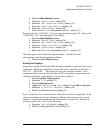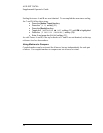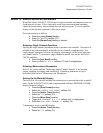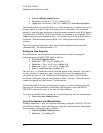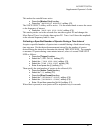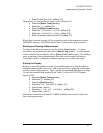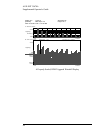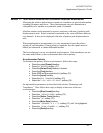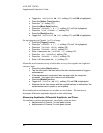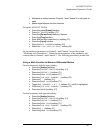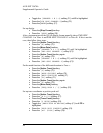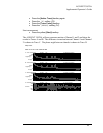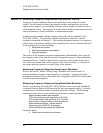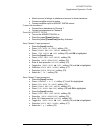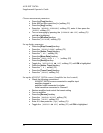
AGILENT 35670A
Supplemental Operator’s Guide
45
Section 17 : Two-Channel Absolute and Differential Amplitude Measurement
Measuring the relative motion between points on a machine can provide information
regarding clearances and forces. These measurements may also demonstrate a
susceptibility of a machine to a particular mode of vibration.
Absolute motion can be measured as a power spectrum, with units of peak-to-peak
displacement in mils. Relative motion is measured as the vector difference between
two channels. It also can be displayed with units of peak-to-peak displacement in
mils.
When acquiring these measurements, it is very important to know the relative
polarity of each transducer. If their polarity is opposite, then the signals must be
added, not subtracted, to obtain differential motion.
The best technique is to use two identical accelerometers. If the transducers are not
the same model, then it is best to determine their relative polarity.
Accelerometer Polarity
To determine the polarity of two accelerometers, follow these steps:
• Press the green [Preset] hardkey
• Press [DO PRESET] softkey (F1).
• Press the [Pause/Cont] hardkey if desired.
• Press the [Freq] hardkey
• Enter 3200 and then press the [Hz] softkey (F2).
• Press the [Input] hardkey.
• Press the [ALL CHANNELS] softkey (F2).
• Select the [CH* AUTO UP ONLY] softkey (F5).
Set up transducer parameters as described in the section “Measuring with
Transducers.” Then follow these steps to display a time trace of the two
accelerometers:
• Press the [Disp Format] hardkey.
• Press the [UPPER/LOWER] softkey (F3).
• Press the [Active Trace] hardkey.
• Press the [A] softkey (F1)
• Press the [Meas Data] hardkey.
• Press the [CHANNEL 1 234] softkey (F1) until 1 is highlighted.
• Press the [TIME CHANNEL 1] softkey (F5)
• Press the [Scale] hardkey.



